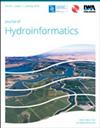Daily reservoir inflow prediction using stacking ensemble of machine learning algorithms
IF 2.2
3区 工程技术
Q3 COMPUTER SCIENCE, INTERDISCIPLINARY APPLICATIONS
引用次数: 0
Abstract
The present study aims to evaluate the potentiality of Bidirectional Long Short-Term Memory (Bi-LSTM), Convolutional Neural Networks (CNNs), eXtreme Gradient Boosting (XGBoost), Light Gradient Boosting Mechine (LGBM), and Random Forest (RF) for predicting daily inflows to the Sri Ram Sagar Project (SRSP), Telangana, India. Inputs to the model are rainfall, evaporation, time lag inflows, and climate indices. Seven combinations (S1–S7) of inputs were made. Fifteen and a half years of data were considered, out of which 11 years were used for training. Hyperparameter tuning is performed with the Tree-Structured Parzen Estimator. The performance of the algorithms is assessed using Kling–Gupta efficiency (KGE). Results indicate that Bi-LSTM with combination S7 performed better than others, as evident from KGE values of 0.92 and 0.87 during the training and testing, respectively. Furthermore, Stacking Ensemble Mechanism (SEM) has also been employed to ascertain its efficacy over other chosen algorithms, resulting in KGE values of 0.94 and 0.89 during training and testing. It has also been able to simulate peak inflow events satisfactorily. Thus, SEM is a better alternative for reservoir inflow predictions.利用机器学习算法的堆叠集合预测每日水库流入量
本研究旨在评估双向长短期记忆 (Bi-LSTM)、卷积神经网络 (CNN)、极梯度提升 (XGBoost)、轻梯度提升机器 (LGBM) 和随机森林 (RF) 在预测印度 Telangana 的 Sri Ram Sagar 项目 (SRSP) 每日流入量方面的潜力。模型的输入为降雨量、蒸发量、时滞流入量和气候指数。输入数据有七种组合(S1-S7)。考虑了 15 年半的数据,其中 11 年用于训练。使用树状结构 Parzen 估计器进行超参数调整。使用 Kling-Gupta 效率 (KGE) 评估了算法的性能。结果表明,采用 S7 组合的 Bi-LSTM 在训练和测试期间的 KGE 值分别为 0.92 和 0.87,表现优于其他算法。此外,还采用了堆叠集合机制(SEM),以确定其相对于其他所选算法的功效,结果显示,在训练和测试期间,其 KGE 值分别为 0.94 和 0.89。它还能令人满意地模拟高峰流入事件。因此,SEM 是预测水库流入量的更好选择。
本文章由计算机程序翻译,如有差异,请以英文原文为准。
求助全文
约1分钟内获得全文
求助全文
来源期刊

Journal of Hydroinformatics
工程技术-工程:土木
CiteScore
4.80
自引率
3.70%
发文量
59
审稿时长
3 months
期刊介绍:
Journal of Hydroinformatics is a peer-reviewed journal devoted to the application of information technology in the widest sense to problems of the aquatic environment. It promotes Hydroinformatics as a cross-disciplinary field of study, combining technological, human-sociological and more general environmental interests, including an ethical perspective.
 求助内容:
求助内容: 应助结果提醒方式:
应助结果提醒方式:


